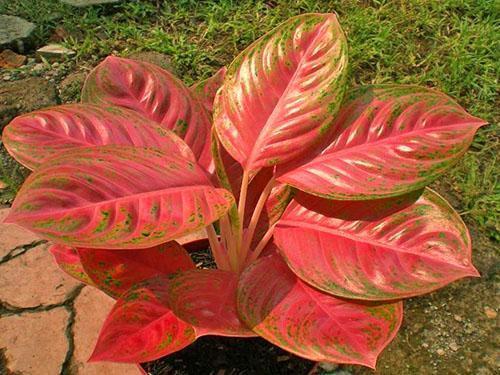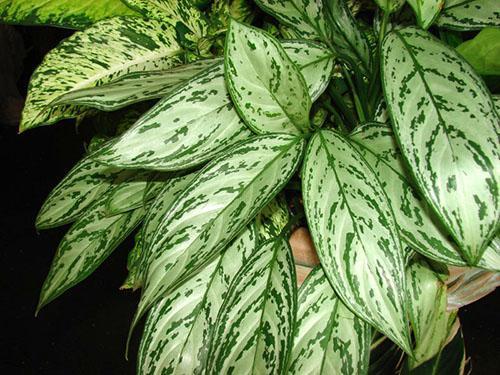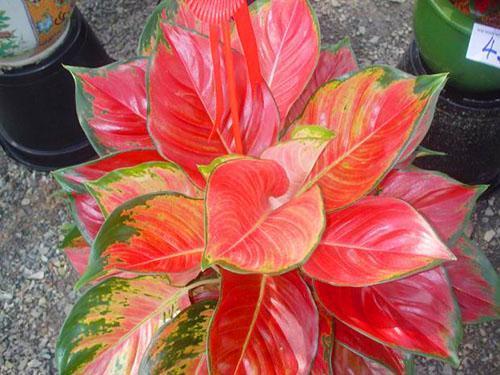Why does aglaonema turn yellow and how to help the plant?
 Most recently, indoor plant lovers met with aglaoneme... The tropical plant is accustomed to growing under the canopy of large trees, tolerates a lack of light. It is perfectly suited for breeding in dark apartments with a lack of sun. The flower is prized for its decorative leaves. If the aglaonema turns yellow, all the beauty of the plant is lost. And since the plant belongs to the aroid family, then special conditions for keeping the tropicana in the apartment must be created.
Most recently, indoor plant lovers met with aglaoneme... The tropical plant is accustomed to growing under the canopy of large trees, tolerates a lack of light. It is perfectly suited for breeding in dark apartments with a lack of sun. The flower is prized for its decorative leaves. If the aglaonema turns yellow, all the beauty of the plant is lost. And since the plant belongs to the aroid family, then special conditions for keeping the tropicana in the apartment must be created.
Aglaonema agricultural technology

 The main value in the relative unpretentiousness of the aglaonema. It does not require such care as the ornamental flowering aroids. Grow a flower within a beginner's ability. And yet the plant loves:
The main value in the relative unpretentiousness of the aglaonema. It does not require such care as the ornamental flowering aroids. Grow a flower within a beginner's ability. And yet the plant loves:
- fertile loose light soil based on peat and heather lands;
- keep warm without direct sunlight;
- moderate watering with warm soft water;
- wiping the leaves with a damp cloth, taking a warm shower and spraying, albeit infrequently.
Aglaonema does not tolerate drafts and cooling below 15 0, even short-term.
The plant likes wide dishes, the drainage layer is not necessary for it. For aglaonema, an accidental one-time waterlogging is not scary, she is more patient. A flower can live in shade conditions, where other flowers wither. In the shade, the leaves become juicy and more contrasting in color. This is why aglaonema is suitable for novice growers.
 In plant language, they signal maintenance problems by changing their appearance. A diseased or starving plant can give a signal. Dots may appear on the leaves, the plant will lose tugor and the leaves will droop, the edges of the sheets begin to dry out or the color is lost. If the leaves of the aglaonema turn yellow, it is uncomfortable and the cause should be looked for.
In plant language, they signal maintenance problems by changing their appearance. A diseased or starving plant can give a signal. Dots may appear on the leaves, the plant will lose tugor and the leaves will droop, the edges of the sheets begin to dry out or the color is lost. If the leaves of the aglaonema turn yellow, it is uncomfortable and the cause should be looked for.
Aglaonema is a poisonous plant with a caustic sap. When leaving, protective measures should be taken. You need to put the flower in a place inaccessible to children and animals.
What do Aglaonema leaves say
 If the flower gets everything it needs and the content matches the biology, the plant is beautiful, the leaves are bright, shiny, fleshy. They have no dots and the stems are clean. When aglaonema grows slowly, this is not a deviation, but a varietal trait. In normal development, 5-6 sheets appear per year. In a too warm room, the plant stretches and loses its decorative effect.
If the flower gets everything it needs and the content matches the biology, the plant is beautiful, the leaves are bright, shiny, fleshy. They have no dots and the stems are clean. When aglaonema grows slowly, this is not a deviation, but a varietal trait. In normal development, 5-6 sheets appear per year. In a too warm room, the plant stretches and loses its decorative effect.
If the leaves change color towards darkening and change shape, then it is necessary to increase watering, the plant dries. But when a gray coating appears on the leaves, this means that there is not enough fresh air in the room. You cannot create a draft.
 However, the clearest indicator of trouble is the yellowing of Aglaonema leaves. Even from school, we know that color is influenced by the formation of chlorophyll in a plant. If the plate turns yellow, serious changes take place in the plant. The reasons may be:
However, the clearest indicator of trouble is the yellowing of Aglaonema leaves. Even from school, we know that color is influenced by the formation of chlorophyll in a plant. If the plate turns yellow, serious changes take place in the plant. The reasons may be:
- improper watering, waterlogging or drought;
- not enough light;
- watering with chlorinated non-settled water;
- watering with hard or insufficiently warm water;
- malnutrition;
- colonization of a plant with insect pests:
- decay of roots due to systematic overflow;
- drafts and keeping at low temperatures;
- natural dying off of the lower leaves, as a symptom of aging.
 Often, yellowing of the aglaonema signals insufficient lighting. Improper watering can be another common cause. In this case, waterlogging is accompanied not only by yellowing, but also by drooping of the leaves. The sad flower should be placed in a warm place and watering should be temporarily stopped. If this does not help, it is possible that the roots have rotted and then the plant needs to be transplanted.
Often, yellowing of the aglaonema signals insufficient lighting. Improper watering can be another common cause. In this case, waterlogging is accompanied not only by yellowing, but also by drooping of the leaves. The sad flower should be placed in a warm place and watering should be temporarily stopped. If this does not help, it is possible that the roots have rotted and then the plant needs to be transplanted.
Regular feeding will help the plant cope with the situation when a flower stalk appears. The yellowing of the leaves during this period is the result of starvation. Top dressing every two weeks with liquid fertilizers will correct the situation.
 It is important to use soft settled water at room temperature for irrigation. The plant does not tolerate calcium salts, chlorine and tobacco smoke in the room. But excessive stiffness will additionally create brown spots on the leaves.
It is important to use soft settled water at room temperature for irrigation. The plant does not tolerate calcium salts, chlorine and tobacco smoke in the room. But excessive stiffness will additionally create brown spots on the leaves.
 Insect colonization and aglaonema diseases are dangerous. A resistant plant with systematic waterlogging and cooling can get sick with fungal diseases. Leaves can suffer from gray rot, become spotty. Such plants will die without fungicide treatment.
Insect colonization and aglaonema diseases are dangerous. A resistant plant with systematic waterlogging and cooling can get sick with fungal diseases. Leaves can suffer from gray rot, become spotty. Such plants will die without fungicide treatment.
 The yellow leaves of aglaonema, upon close examination, turn out to be infested with sucking insects:
The yellow leaves of aglaonema, upon close examination, turn out to be infested with sucking insects:
- aphids;
- scale insect;
- shield;
- red spider mite;
- thrips.
 With a large population, only insecticidal preparations can help. If there are few pests, the treatment of leaves in the shower, and soap solutions will save.
With a large population, only insecticidal preparations can help. If there are few pests, the treatment of leaves in the shower, and soap solutions will save.
It is necessary to process plants with household chemicals at home only with approved preparations and not exceeding the dosage. During the processing period, all other living creatures must be removed from the premises.
Insects can move in if the quarantine for new plants is not observed. Dry room air promotes the reproduction of spider mites. You can exterminate it with the help of Actellik.
 Mealybugs will destroy the leaves, but you can save yourself with soapy water or Carbaphos. Aphids can be destroyed with pyrethrum. But if she rolled the sheet into a tube, then you need to remove the entire plate.
Mealybugs will destroy the leaves, but you can save yourself with soapy water or Carbaphos. Aphids can be destroyed with pyrethrum. But if she rolled the sheet into a tube, then you need to remove the entire plate.
Why do the leaves turn yellow)))) And in a dark place it was and put it lighter, still the leaves turn yellow quietly
Your plant's leaves are likely to turn yellow from improper care. Check the root system, there may be rotting from excessive watering. If the roots are good without rot, check the trunk and bottom of the leaves for pests.
High air dryness can also affect yellowing.
Mine turns yellow too. Looks like the process has just begun. The other day I took it out into the street (into a closed courtyard) and today I noticed a tarnishing of the green color, a slight yellowing. What do you think could be? (
Maybe the sun got sick or was it cold at night? Watch if the yellowing will spread further, if anything, check the roots and feed.
dots on one side of the leaf are visible on the leaves of the aglaonema, no insects are visible, the leaves give the impression of being healthy. Each newly unfolding sheet has light dots in the light along one edge in a straight line along a vertical vein. Treatment with Fitoverm with green soap did not change the situation. An attempt to take a photo was unsuccessful. Not visible in the photo.
If the flower is outwardly healthy, perhaps this is a varietal feature. Some species of central vein aglaonema have small light spots. See if they will grow and will not change the "well-being" of the flower.
thank. But there is a peculiarity: firstly, these tiny dots appear on one side (from which the sheet begins to unwind).secondly, one of the points has increased, turned into a hole with a dead edge. Still looks like a pest. Once already treated with phytoverm, even before the appearance of this hole. Now you have to process it again. I would be grateful if you can tell me a treatment tool. While I wash the leaves with soapy water.
You can try Aktara or Aktellik. But nevertheless, it would be desirable to look at the sheet ...
Thank you, repeated attempts to take a photo were unsuccessful - all the dots in the photo merge. I didn’t find Aktellik (they said they don’t sell it now), but I’ll try to treat it with Acarin. But I would like to ask, is it possible to mix acarin with green soap (alkaline medium), will this not weaken the effect of the active substance (avertin)?
Acarin cannot be combined with drugs that have an alkaline reaction.
seems to have taken a picture
hello, my aglonema has sticky drops. from what can it be?
There can be many reasons: 1. Diligent watering - the flower “cries”, getting rid of excess moisture. Increase the time between waterings and do not overfill. 2. Shield. In this case, the spots are at first light and soft, like growths, then darken and coarse. This is a pest, they get rid of it mechanically, plus treatment with soapy water or Aktara. 3. Powdery mildew, the beginning of the disease. I need a fungicide treatment. 4. Downy mildew (if additionally there are brown spots on the leaves). Copper sulfate or fungicide treatment.
Good day! Help me please. We gave the cuttings of the sinew as cuttings of the bush dieffenbachia. Hence the mistakes in leaving. What to do with a flower? Thank you in advance)
In my opinion, the fungus is already developing here. I would treat it with a fungicide. And a rooted stalk? If so, then you need to change the soil.